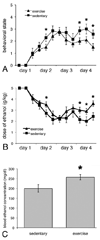Exercise neuroprotection in a rat model of binge alcohol consumption
- PMID: 20028365
- PMCID: PMC2936244
- DOI: 10.1111/j.1530-0277.2009.01105.x
Exercise neuroprotection in a rat model of binge alcohol consumption
Abstract
Background: Excessive alcohol intake produces structural and functional deficits in corticolimbic pathways that are thought to underlie cognitive deficits in the alcohol use disorders (AUDs). Animal models of binge alcohol administration support the direct link of high levels of alcohol consumption and neurotoxicity in the hippocampus and surrounding cortex. In contrast, voluntary wheel running enhances hippocampal neurogenesis and generally promotes the health of neurons.
Methods: We investigated whether voluntary exercise prior to binge alcohol exposure could protect against alcohol-induced cell loss. Female Long-Evans rats exercised voluntarily for 14 days before undergoing 4 days of binge alcohol consumption. Brains were harvested immediately after the last dose of alcohol and examined for various histological markers of neurodegeneration, including both cell death (FluoroJade B) and cell birth (Ki67) markers.
Results: Rats that exercised prior to binge exposure were significantly less behaviorally intoxicated, which was not a result of enhanced hepatic metabolism. Rats that exercised prior to binge alcohol consumption had reduced loss of dentate gyrus granule cells and fewer FluoroJade B positive cells in the dentate gyrus and associated entorhinal-perirhinal cortex compared to nonexercisers. However, exercise did not protect against cell death in the piriform cortex nor protect against alcohol-induced decreases in cell proliferation, evidenced by a similar alcohol-induced reduction in Ki67 labeled cells between exercise and sedentary rats.
Conclusions: We conclude that exercise can reduce behavioral sensitivity to ethanol intoxication and protect vulnerable brain areas from alcohol-induced cell death. Exercise neuroprotection of alcohol-induced brain damage has important implications in understanding the neurobiology of the AUDs as well as in developing novel treatment strategies.
Figures






Similar articles
-
The effects of exercise on adolescent hippocampal neurogenesis in a rat model of binge alcohol exposure during the brain growth spurt.Brain Res. 2009 Oct 19;1294:1-11. doi: 10.1016/j.brainres.2009.07.090. Epub 2009 Aug 6. Brain Res. 2009. PMID: 19647724 Free PMC article.
-
Reversibility of object recognition but not spatial memory impairment following binge-like alcohol exposure in rats.Neurobiol Learn Mem. 2010 Nov;94(4):538-46. doi: 10.1016/j.nlm.2010.09.006. Epub 2010 Sep 16. Neurobiol Learn Mem. 2010. PMID: 20849966 Free PMC article.
-
Recurrent binge ethanol is associated with significant loss of dentate gyrus granule neurons in female rats despite concomitant increase in neurogenesis.Neuropharmacology. 2019 Apr;148:272-283. doi: 10.1016/j.neuropharm.2019.01.016. Epub 2019 Jan 16. Neuropharmacology. 2019. PMID: 30659841
-
A cognitive model of binge drinking: the influence of alcohol expectancies and drinking refusal self-efficacy.Addict Behav. 2004 Jan;29(1):159-79. doi: 10.1016/s0306-4603(03)00076-5. Addict Behav. 2004. PMID: 14667427 Review.
-
Mechanisms of neurodegeneration and regeneration in alcoholism.Alcohol Alcohol. 2009 Mar-Apr;44(2):115-27. doi: 10.1093/alcalc/agn079. Epub 2008 Oct 21. Alcohol Alcohol. 2009. PMID: 18940959 Free PMC article. Review.
Cited by
-
Exercise as a novel treatment for drug addiction: a neurobiological and stage-dependent hypothesis.Neurosci Biobehav Rev. 2013 Sep;37(8):1622-44. doi: 10.1016/j.neubiorev.2013.06.011. Epub 2013 Jun 24. Neurosci Biobehav Rev. 2013. PMID: 23806439 Free PMC article. Review.
-
Type 2 Neural Progenitor Cell Activation Drives Reactive Neurogenesis after Binge-Like Alcohol Exposure in Adolescent Male Rats.Front Psychiatry. 2017 Dec 15;8:283. doi: 10.3389/fpsyt.2017.00283. eCollection 2017. Front Psychiatry. 2017. PMID: 29326611 Free PMC article.
-
Distinct neurobehavioral dysfunction based on the timing of developmental binge-like alcohol exposure.Neuroscience. 2014 Nov 7;280:204-19. doi: 10.1016/j.neuroscience.2014.09.008. Epub 2014 Sep 18. Neuroscience. 2014. PMID: 25241068 Free PMC article.
-
Reactive, Adult Neurogenesis From Increased Neural Progenitor Cell Proliferation Following Alcohol Dependence in Female Rats.Front Neurosci. 2021 Sep 14;15:689601. doi: 10.3389/fnins.2021.689601. eCollection 2021. Front Neurosci. 2021. PMID: 34594180 Free PMC article.
-
Wheel running reduces ethanol seeking by increasing neuronal activation and reducing oligodendroglial/neuroinflammatory factors in the medial prefrontal cortex.Brain Behav Immun. 2016 Nov;58:357-368. doi: 10.1016/j.bbi.2016.08.006. Epub 2016 Aug 16. Brain Behav Immun. 2016. PMID: 27542327 Free PMC article.
References
-
- Agartz I, Momenan R, Rawlings RR, Kerich MJ, Hommer DW. Hippocampal volume in patients with alcohol dependence. Arch Gen Psychiatry. 1999;56:356–363. - PubMed
-
- Alessio HM, Hagerman AE, Nagy S, Philip B, Byrnes RN, Woodward JL, Callahan P, Wiley RL. Exercise improves biomarkers of health and stress in animals fed ad libitum. Physiol Behav. 2005;84(1):65–72. - PubMed
-
- Ardies CM, Morris GS, Erickson CK, Farrar RP. Both acute and chronic exercise enhance in vivo ethanol clearance in rats. J Appl Physiol. 1989;66(2):555–560. - PubMed
-
- Asano M, Kaneoka K, Nomura T, Asano K, Sone H, Tsurumaru K, Yamashita K, Matsuo K, Suzuki H, Okuda Y. Increase in serum vascular endothelial growth factor levels during altitude training. Acta Physiol Scand. 1998;162(4):455–459. - PubMed
-
- Bengochea O, Gonzalo LM. Effect of chronic alcoholism on the human hippocampus. Histol Histopathol. 1990;5(3):349–357. - PubMed
Publication types
MeSH terms
Substances
Grants and funding
LinkOut - more resources
Full Text Sources

